The document presents a study of the Minimum Reconfiguration Probability Routing (MRPR) algorithm for routing and wavelength assignment (RWA) in wavelength interchange networks, comparing its performance against Adaptive Unconstrained Routing (AUR) and Least Loaded Routing (LLR) algorithms. The MRPR algorithm focuses on minimizing link and router failures while optimizing reliability and blocking probabilities. It employs Kalman filter techniques to enhance routing decisions based on network state and failure statistics.
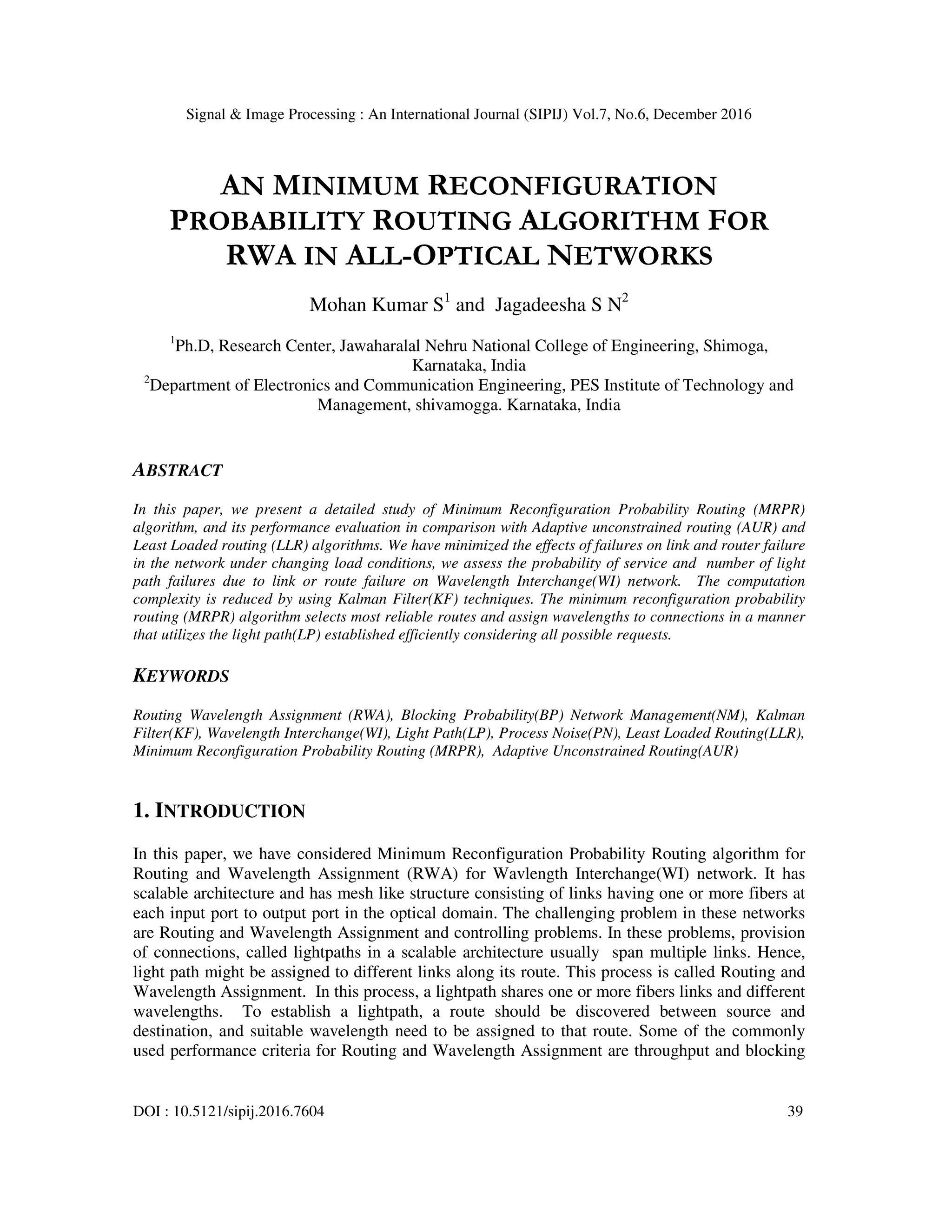
![Signal & Image Processing : An International Journal (SIPIJ) Vol.7, No.6, December 2016 40 probability[10]. There are many RWA algorithms proposed for this purpose with optimal solutions[10]. The main assumption of these algorithms are that, traffic volume is static for a long time period and these networks are reconfigured only to reflect changes in the long term traffic demand[1]. Although static demand has been reasonable a assumption for voice data communication. In current trends and future, data intensive networks are rapidly changing. Therefore dynamic RWA algorithms which support request arrivals and lightpath terminations at stochastic/randaom times are needed. Hence, predefined set of routes are searched in a predefined order to accommodate the request. Then the smallest index randomly selects a wavelength available on the route. If not, request is blocked. Usually one or more minimum hop routes are used and fixed order search is carried out without taking into account, the congestion on the link. In this paper, we present the comparative study and performance evaluation of Minimum Reconfiguration Probability Routing (MRPR) algorithm, over Adaptive Unconstrained Routing (AUR) and Least Loaded Routing (LLR) methods. An Optical switch has ability to minimize the effects of failures on network performance by using a suitable routing and wavelength assignment method without disturbing other performance criteria such as network management and blocking probability[4]. The main challenge in the Wavelength Interchange (WI) and Wavelength Routing Network (WRN) are the provision of connections called lightpaths between the users of network. One of the Routing Wavelength Assignment method known as Minimum Reconfiguration Probability Routing algorithm is implemented [3][15]. Its performance comparison study over AUR and LLR are presented. This algorithm makes use of the network state information at the time of routing to find the optimum path. By choosing as much reliable router/links as possible in the RWA process, it is possible to minimize the mean number of light paths broken due to failure. However, considering only reliability characteristics, lightpaths may have to be routed on longer routes and blocking performance may be reduced significantly. For this reason, the algorithm is based on the joint optimization of the probability of reconfiguration due to router/link failures and probability of blocking for the future requests. Therefore effect of potential router/link failures and blocking probability is measured and also minimized without disturbing performance. Hence, lightpath arrival/holding time and failure arrival statistics collected for each link and router, as well as the network state information collected and updated using kalman filter methods at the time of request arrival are used in routing decisions. That is, the behavior of the network is predicted by current state information and statistics of the past, to assign the most reliable path to the lightpath requests[9]. The routing algorithms proposed so far for optical networks uses present state of the network[3]. Using this information most of authors proposed wavelength pair routing and wavelenght assigment function. An adaptive RWA algorithm makes use of the network state information at the time of routing to find the optimum path. Least loaded routing(LLR) and Adaptive Unconstrained Routing (AUR) are the examples for adaptive RWA process[3]. In the following section, we present a MRPR for routing and wavelength assignment for the most reliable route-wavelength pair for a light path request. It uses the lightpath request arrival statistics between the routers, and failure arrival statistics for links and Kalman filter employed on router/linker to predict network state and the reconfiguration probability of route-wavelength pairs, and hence selects the most reliable route-wavelength pair. Finally a comparative study and performance are presented in the section 3.0. The results and concluding remarks and directions for future work are presented in the section 4.0 and section 5.0.](https://image.slidesharecdn.com/7616sipij04-170109050630/75/AN-MINIMUM-RECONFIGURATION-PROBABILITY-ROUTING-ALGORITHM-FOR-RWA-IN-ALL-OPTICAL-NETWORKS-2-2048.jpg)
![Signal & Image Processing : An International Journal (SIPIJ) Vol.7, No.6, December 2016 41 2. MRPR IN WI NETWORKS In Wavelength Interchange networks, wavelength routers have a full set of wavelength converters at the output ports and they are able to change the wavelength over every light path passing through it. Hence, blocking of requests leading to wavelength conficts, can be measured and reduced significantly[15]. Wavelength router can also change the wavelength, it optimally reduce the ligth path routing problem after wavelength assignment problem is solved. The minimum reconfiguration probability routing algorithm is statistically predictive optimal routing and wavelength assignment algorithm because; it aims to assign the most reliable route- wavelength pair for a lightpath request. It uses the lightpath request arrival and failure statistics information from the routers, and predicts the reconfiguration probability of route-wavelength pairs, and selects the most reliable route-wavelength pair. The algorithm starts by assigning a cost value to each network element (router/link) and a multiple shortest path computed, then an optimal shortest path is used as the most reliable path. To find the shortest route with minimum reconfiguration probability of light path request for reliable path for share per node (SpN) network, we use the Bellman Ford algorithm to find the shortest path. A kalman filter is employed at each router/link to retrieve the state of network and minimum reconfiguration probability of light path request for reliable path reconfiguring for the WI network. The following two sections determine these costs, and its route, a lightpath through the network. 2.1 COST DETERMINATION Let ‘x’ be a random variable representing failure inter-arrival times, ݂ሺݔሻ be the probability density function of failure inter-arrival times for link (i, j), y be a random variable representing lightpath holding times and ℎ௦ௗሺݕሻ be the probability density function of lightpath times for the router/link pair from source to destination (s-d). It is possible to evaluate the probability of failure of lightpath of the link (i, j), between routers source‘s’ and destination ‘d’ using these parameters. Let ܲ௦ௗ be the probability of failure of lightpath in link (i, j) between router source and destination. It is given by: ܲ௦ௗ = ሺ ℎ௦ௗሺݕሻ݂ሺݔሻ݀ݔ݀ݕ ሻ ௬ ௫ୀିஶ ∞ ௬ୀିஶ (1) It is assumed that the failure arrival method is memory-less, hence it is the probability of failure of lightpath of the link (i, j) in the interval (t, t+dt). It will not fail prior to the time t, hence it is independent of time t. Rewriting the equation (1). ܲ௦ௗ = ൣ ݂ሺݔሻ ௬ ௫ୀିஶ ݀ݔ൧ ∞ ௬ୀିஶ ℎ௦ௗሺݕሻ݀ݕ = ݃ሺݕሻℎ௦ௗሺݕሻ݀ݕ ∞ ௬ୀିஶ (2) Tchebycheff Inequality[21], is a measure of the concentration of a random variable near its mean µ and its variance v= σ2 , and can be used to find the upper bound for equation (2). ܲ௦ௗ ሾݔ − ߤሿ ≥ ε} = ݂ሺݔሻ݀ݔ + ௫ିఓ ିஶ ݂ሺݔሻ݀ݔ ≤ ∞ ௫ାఓ ఌమ (3)](https://image.slidesharecdn.com/7616sipij04-170109050630/75/AN-MINIMUM-RECONFIGURATION-PROBABILITY-ROUTING-ALGORITHM-FOR-RWA-IN-ALL-OPTICAL-NETWORKS-3-2048.jpg)
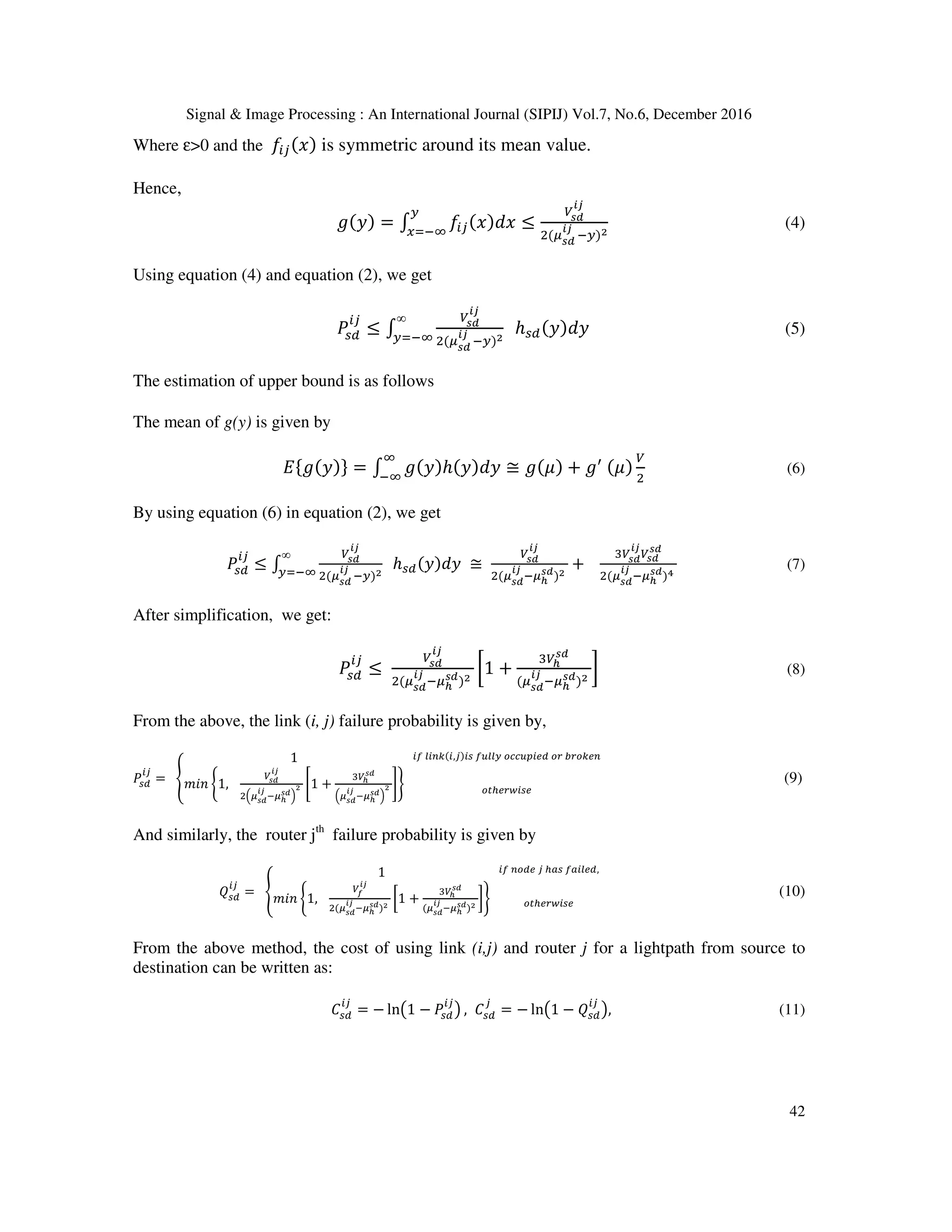
![Signal & Image Processing : An International Journal (SIPIJ) Vol.7, No.6, December 2016 43 2.2 Routing decision for MRPR, LLR and AUR techniques In the previous section ܲ௦ௗ and ܳ௦ௗ represent the estimated failure probabilities. Then the ൫1 − ܲ௦ௗ ൯ and ൫1 − ܳ௦ௗ ൯ gives the probabilities of links (i, j) and route j are considered for routing a lightpath between source s to destination d. Here, probabilities are estimated for each network element independently. Hence, finding the shortest the path between router s and destination d in terms of cost can be written as: ܥ௦ௗ = − lnሾ൫1 − ܲ௦ௗ ൯ ൫1 − ܳ௦ௗ ൯] (12) ܥ = ܥ௦ௗ + ܥ௦ௗ (13) Suppose if all link cost are equal, then the AUR and LLR routing approach will be adopted for routing decision. The kalman filter method is well suited for distributed operation since, it is possible to build an algorithm based on distributed routing algorithm. In this study, routers collect the failure statistics for present state, future prediction, updation of network state, their adjacent links and collects the arrival statistics from the router. Hence, router can initiate the routing algorithm with parameters’ ߤ ௦ௗ and ݒ ௦ௗ . Suppose if wavelength converters are employed in routers, a wavelength can be assigned to a lightpath randomly or statistically at each link. This approach is called statistically predictive and optimal wavelength routing. It is also called Minimum Reconfiguration Probability Routing. The two possibilities for wavelength selection are first fit or random. In first fit wavelength assignment, the smallest index wavelength is chosen. In random wavelength assignment, one of the available wavelengths can be selected. First fit assignment methods are reported to be better than random methods and it is used in most of RWA algorithms [19]. A Markov Decision Process is used in WI networks to estimate the average number of future rejections on a router. The total cost is the estimation of the Mean number future rejections requests in the WI network. By accommodating the MRPR algorithm in the router, the statistics related lightpath arrival/holding time, failure arrival statistics for each link and routers, network state information at the time of request arrival are used in routing decision. After solving the routing problem, wavelengths on the links along the route can be assigned randomly. In order to find the route with minimum reconfiguration probability for a lightpath request, a simple auxiliary graph G= (N,E),where nodes N represent the routers and each directed edge(i,j), E represents the link (i,j) from router i to router j, is constructed. Then, cost of each edge(i,j) is set to: ܥ = − ln൫1 − ܨ൯ − ln൫1 − ܨ൯ , − ln൫1 − ܴ൯ (14) Where, Fij is the probability of reconfiguration due to failure of the link (i,j) and Fj is the probability of reconfiguration due to failure on router j for the lightpath to be routed and ܴ is the probability of reconfiguration due to repacking on the link (i j). In equation (14), Edge cannot be used which means that the link (i,j) has no free wavelength channel at the time of routing[3][15], if the lightpaths assigned are uniformly distributed over the wavelength in link (i,j) (i.e arrival rates of lightpaths at different wavelenghts are the same).](https://image.slidesharecdn.com/7616sipij04-170109050630/75/AN-MINIMUM-RECONFIGURATION-PROBABILITY-ROUTING-ALGORITHM-FOR-RWA-IN-ALL-OPTICAL-NETWORKS-5-2048.jpg)
![Signal & Image Processing : An International Journal (SIPIJ) Vol.7, No.6, December 2016 44 Wavelength converters are exclusively expensive devices and hence it is treated as routers or switches. Therefore, some router architectures required Share per Node (SpN) and share per link method. Share per node architectures (network) are limited numbers of converters, among the lightpaths, in these networks, light path requests arrive at each routers randomly, and not blocked, they stay on the network for a random amount of time. It is assumed that, each links/router may fail at random times, so failures are re-routed on new path [14]. Hence, most of authors proposed share a limited channel number based WI routers. Although MRPR can be employed for the WI architectures. MRPR routing method may cause blocking of future requests, which need wavelength conversion at the router. Therefore, we consider the repacking of lightpaths, which are using converters in a router. For this purpose, we use converter usage statistics such as mean arrival time rate and mean holding time of light paths. Establishing a light path between the routers source ‘s’ and destination ‘d’ in SpN network can be constructed as follows. • For each wavelength w=1..W and router n, create the nodes ݅௪ and ௪ which represent the input and output ports of the routers n at wavelength w respectively. • For each wavelength v, w=1..W and routers n create the edges (݅௩, ௪) corresponding to wavelength conversion in the router n, • For each wavelength w=1..W and each link (m, n) from router m to router n, create the directed edges (௪, ݅௪) which represent the channels at wavelength w in the link (m, n). • Create the nodes ݎ௦ and ݎௗ corresponding to source and destination terminals for the lightpath • For each wavelength w=1..W create the edges (ݎ௦, ݅௦௪) and (ௗ௪, ݎௗ) After construction of graph for a share per node to route a lightpath from a source to destination are illustrated as shown in Figure (2). The graph is constructed for v, w=1, 2,..W and each router n and m, the cost of edges (ݎ௦, ݅௦௪) and (ௗ௪, ݎௗ) as shown in Figure (2). for w=1..W are set to zero. The cost of each edge (௪, ݅௪) are set to: ܥ௪ = ቄ ∞ − lnሺ1 − ܨሻ − lnሺ1 − ܴሻ ௧ ௪௩௧ ௪ ሺ,ሻ ௧ ௪௦ ሺ15ሻ Cost of each edge (݅௩, ௪), for v ≠ w, ܺ௩௪ = ቄ ∞ − lnሺ1 − ܨሻ − lnሺ1 − ܴሻ ݊ ݂݁݁ݎ ܿݏݎ݁ݐݎ݁ݒ݊ ݅݊ ݊ ݎ ݊ ℎܽݏ ݂݈ܽ݅݁݀, ݐℎ݁ݎ ݁ݏ݅ݓ ሺ16ሻ And the cost of each edge (݅௪, ௪) ܺఓ = ቄ ∞ − lnሺ1 − ܨሻ ௦ ௗ ௧ ௪௦ ሺ17) Figure 1 : A share per node network](https://image.slidesharecdn.com/7616sipij04-170109050630/75/AN-MINIMUM-RECONFIGURATION-PROBABILITY-ROUTING-ALGORITHM-FOR-RWA-IN-ALL-OPTICAL-NETWORKS-6-2048.jpg)
![Signal & Image Processing : An International Journal (SIPIJ) Vol.7, No.6, December 2016 45 Where ܨ and ܨ are the probabilities of reconfiguration due to failure on the WI router n and link (m, n) respectively, ܴ is the probability of reconfiguration due to repacking on the link (m,n) and ܴ is the probability of reconfiguration due to repacking for a lightpath using a converter on the router n which is obtained from the equation (15). ܴ = ாሺ௫,ఘሻ ௫.ாሺ௫బ,ఘሻ (18) Similarly, LLR and AUR methods are applied to WI network to find out the route and reliable path of network. Routing in optical networks is simply inherited from traditional circuit switching. Among all the routing algorithms, the Least Load Routing (LLR) is the most popular one in traditional circuit switched networks [22]. Naturally there were also attempts at studying LLR in the context of optical networks in; however, it has only been applied in two types of optical networks: a network with no wavelength conversion and a network with full wavelength conversion (i.e. every node has a wavelength converter). An LLR-based routing algorithm in optical networks with wavelength conversion neither has been formulated nor studied to the extent of our knowledge. In AUR algorithm, all paths between source and destination are considered in routing decisions. In LLR all paths between source and destination considered based on least cost and routing decision will be taken. AUR is fundamentally different from LLR, in that, it is not limited to a set of predefined search sequence. The optimal lightpath is obtained by finding the shortest path in WI networks, both do not use convertor. Figure 2 : Share per node graphical representation 3. PERFORMANCE EVALUATION In order to evaluate the performance of network, we have considered the network shown in the Figure (3) having 6 routers and 13 links. All the links are unidirectional light paths and are](https://image.slidesharecdn.com/7616sipij04-170109050630/75/AN-MINIMUM-RECONFIGURATION-PROBABILITY-ROUTING-ALGORITHM-FOR-RWA-IN-ALL-OPTICAL-NETWORKS-7-2048.jpg)
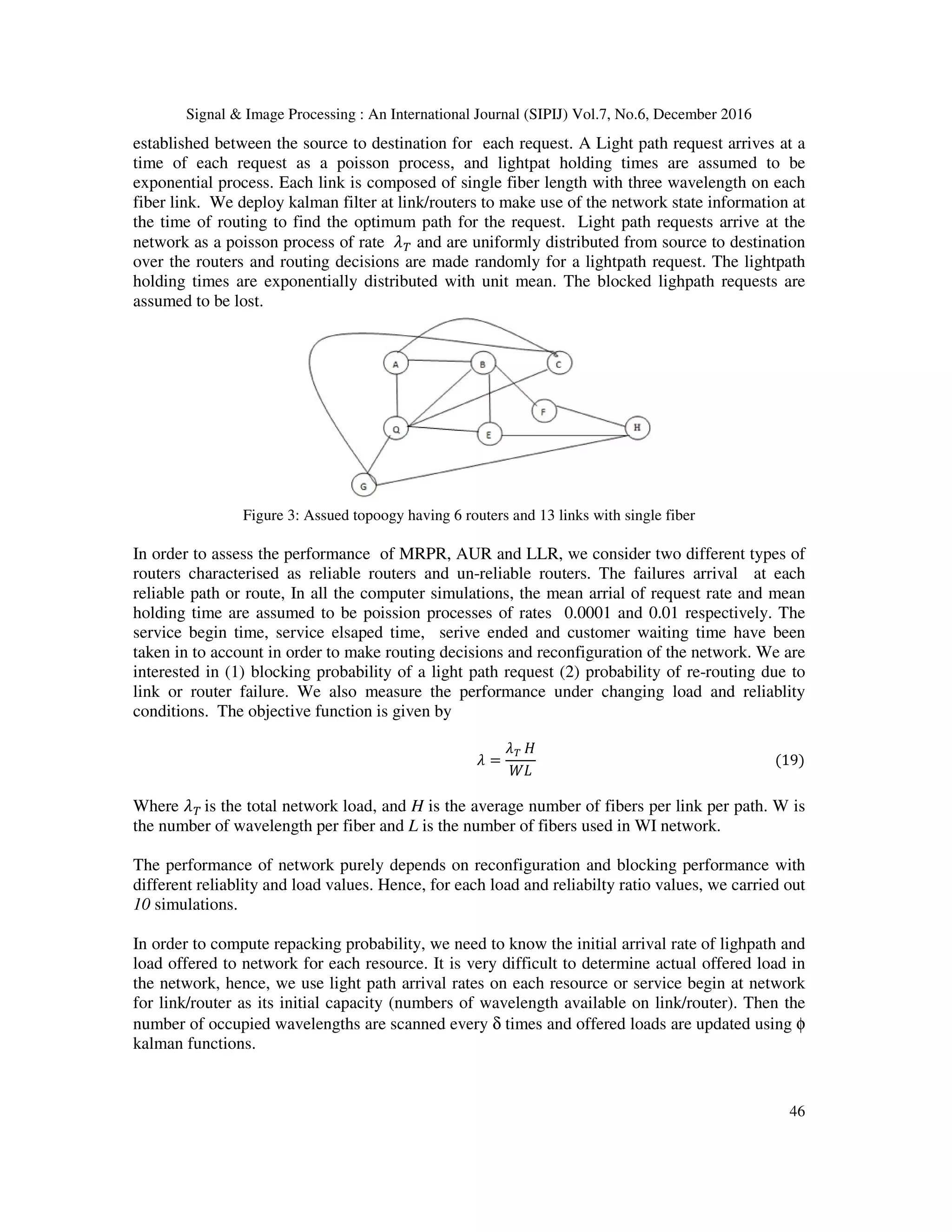
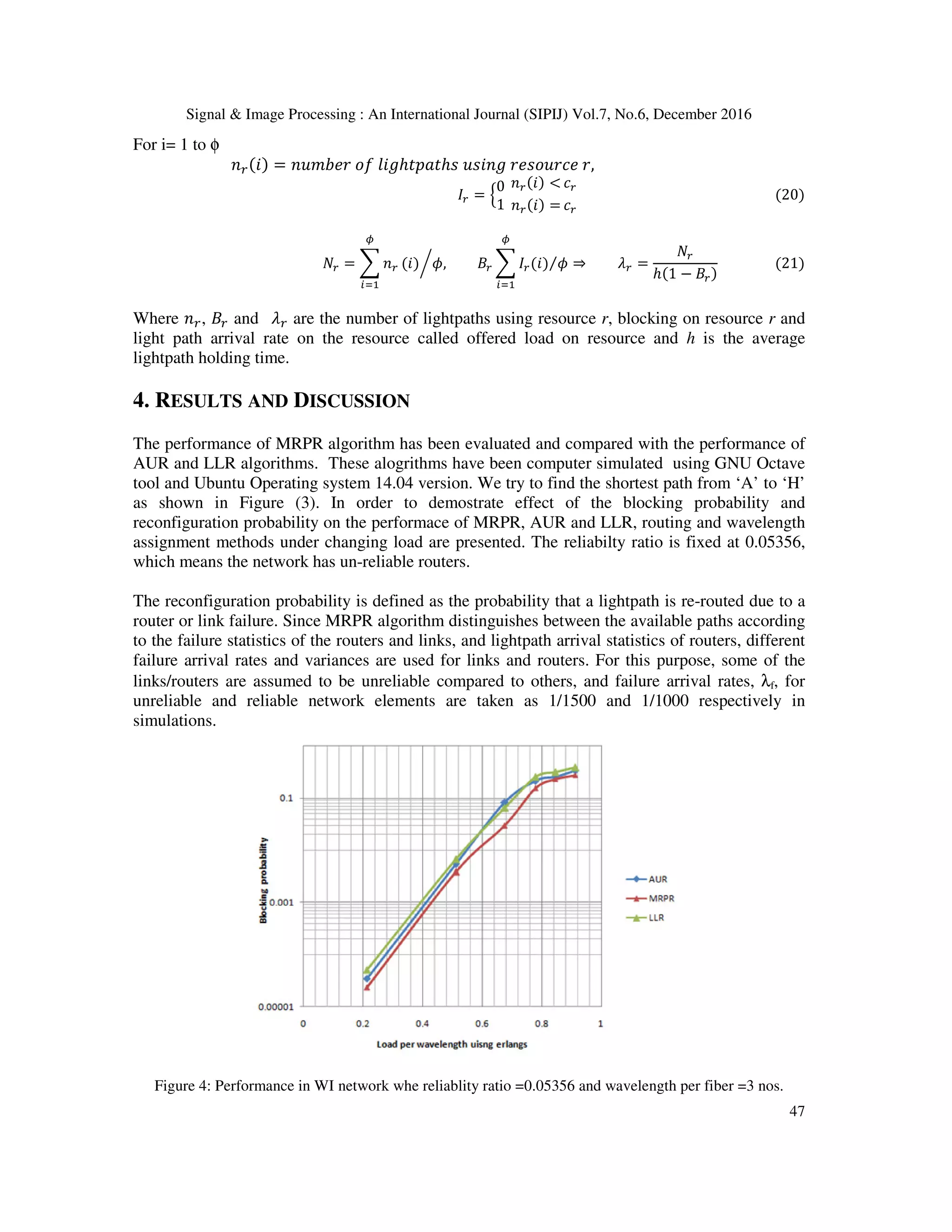
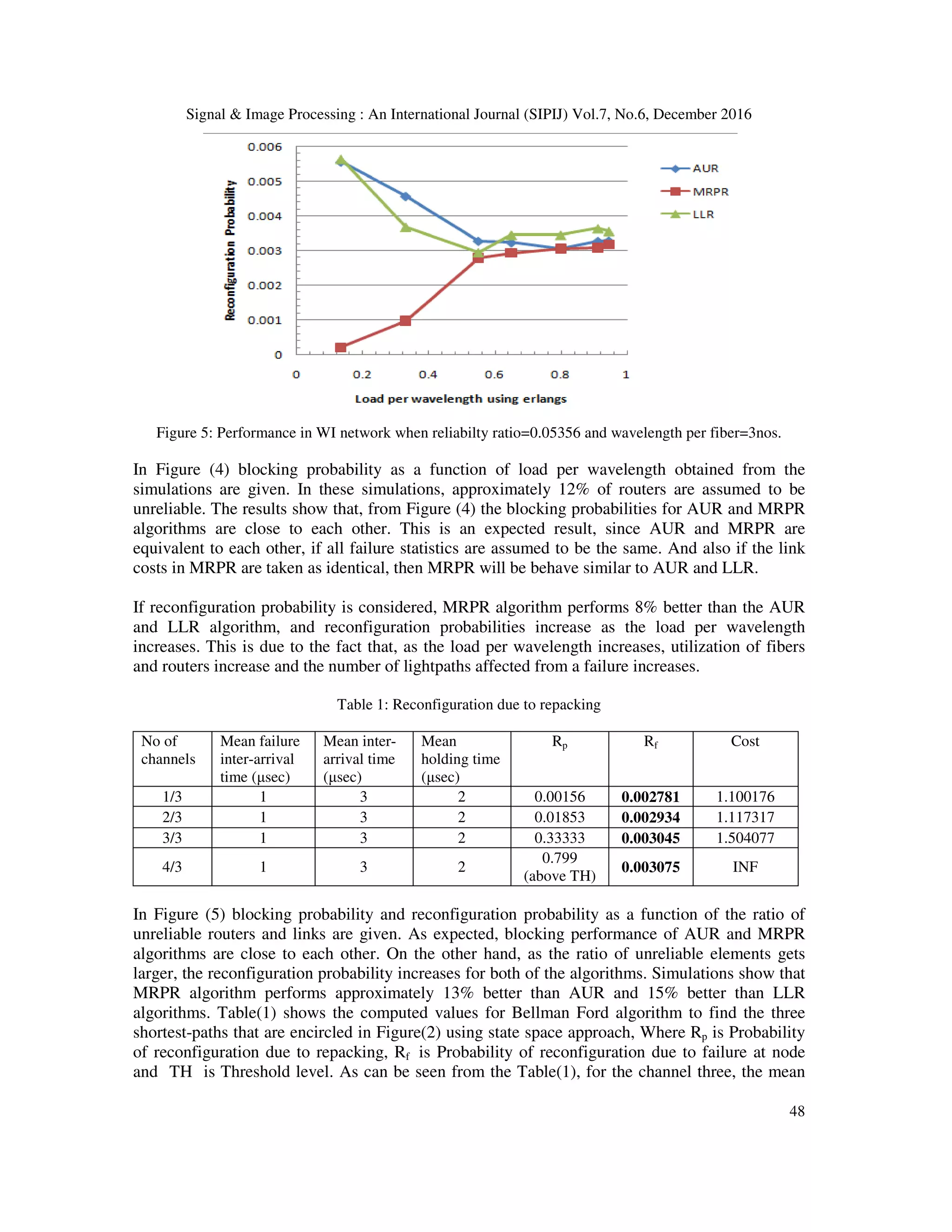
![Signal & Image Processing : An International Journal (SIPIJ) Vol.7, No.6, December 2016 49 failure inter-arrival time is 1.0 µsec. Mean inter-arrival time 3.0 µsec, and mean holding time is 2.0µsec. The Probability of reconfiguration due to repacking is 0.33333, and Probability of reconfiguration due to failure is 0.003045 and the cost 1.504077. The proposed method to be any pratical value obviously, the process of taking statistics should not imply prohibitive costs. The cost is not prohibitive and Probability of reconfiguration is neglible. In MRPR algorithm reliable paths between souce and destination are considered in the routing decisions. Since the statistics are used in conjunction with the present state information, it is naturally expected, that Kalman filter apporach, achieves optimaly better routing performance compared to earlier adaptive RWA algorithms. 5. CONCLUSION In this paper, a detailed study of MRPR algorithm has been presented and its performance has been evaluated in comparision with AUR and LLR algorithms for the RWA problem in all optical networks. The study has been made considering the probability of reconfiguration due to failure of the link (i, j) and the probability of reconfiguration due to failure on router j for the lightpath to be routed and the probability of reconfiguration due to repacking on the link (i j). The extensive computer simulations have reaveled that the MRPR algorithm is a better choice for solving the RWA problems. We suggest that further research in this direction is likely to find the over-head time taken to MRPR alogrithm for RWA problems. REFERENCES [1] Stefano Baroni and Polina Bayvel, Wavelength requirements in arbitrarily connected wavelength- routed optical networks, Lightwave Technology, Journal of 15 (1997), no. 2, 242-251. [2] Ezhan Karasan and Ender Ayanoglu, Performance of wdm transport networks, Selected Areas in Communications, IEEE Journal on 16 (1998), no. 7, 1081-1096. [3] Altan Kocyigit and Semih Bilgen, Statistically predictive optimal wavelength routing, Optical Networks Magazine (2003). [4] Altan Kocyigit, and Semih Bilgen, All-optical networking, Turkish Journal of Electrical Engineering & Computer Sciences 9 (2001), no. 2, 69-122. [5] Peter S Maybeck, Stochastic models, estimation, and control, vol. 3, Academic press, 1982. [6] The kalman filter, an introduction to concepts, Autonomous Robot Vehicles, Springer, 1990, pp. 194- 204. [7] Athanasios Papoulis and S Unnikrishna Pillai, Probability, random variables, and stochastic processes, Tata McGraw-Hill Education, 2002. [8] Rajiv Ramaswami, Multiwavelength lightwave networks for computer communication, Communications Magazine, IEEE 31 (1993), no. 2, 78-88. [9] Marcelo Yannuzzi, Xavier Masip-Bruin, Sergio Sanchez-Lopez, Eva Marin-Tordera, Josep Sole- Pareta, and Jordi Domingo-Pascual, Interdomain rwa based on stochastic estimation methods and adaptive filtering for optical networks., GLOBECOM, 2006.](https://image.slidesharecdn.com/7616sipij04-170109050630/75/AN-MINIMUM-RECONFIGURATION-PROBABILITY-ROUTING-ALGORITHM-FOR-RWA-IN-ALL-OPTICAL-NETWORKS-11-2048.jpg)
![Signal & Image Processing : An International Journal (SIPIJ) Vol.7, No.6, December 2016 50 [10] Jay Y Yoo and Subrata Banerjee, Design, analysis, and implementation of wavelength-routed all- optical networks: routing and wavelength assignment approach, IEEE Communications Surveys, Broadband Network area (1997). [11] Y.Donoso G.A Montoya, F.Solano, An Energy-Efficient and Routing Approach for Position, Estimation using Kalman Filter Techniques in Mobile WSNs, CCC publications, International Journal of Computer Communications and Control ISSN-1841-9836, 10(4):500-507 August 2015. [12] Mohana Kumar S, and Jagadeesh S N, “Routing and Wavelength Assignment for Optical Networks using Link State Space Technique”, in Proceedings of the 6th IETE National Conference on RF & Wireless, 09-11 May 2013 shimoga Karnataka pp. 116–119. [13] Mohan Kumar S, Jagadeesh SN, Swaroop “A case study on Markov model for double fault tolerance, comparing cloud based storage system”, IJARCCE vol 4, Issue 11, November (2015) pp 240-245. [14] Boudriga, Noureddine. "Optical burst switching protocols for supporting QoS and adaptive routing." Computer Communications 26.15 (2003): 1804-1812. [15] SN, Jagadeesha, and Mohan Kumar S. "Routing in all optical networks using recursive state space technique." Signal & Image Processing: An International Journal (SIPIJ) Vol.7, No.2, (2016) pp 23- 37. [16] Xiang, Lei, Dingshan Gao, Yu Yu, "Silicon-Based Integrated Comb Filter and Demultiplexer for Simultaneous WDM Signal Processing." Selected Topics in Quantum Electronics, IEEE Journal of 20.4 (2014): 240-247. [17] Qin, Haohao, et al. "Power allocation and time-domain artificial noise design for wiretap OFDM with discrete inputs." Wireless Communications, IEEE Transactions on 12.6 (2013): 2717-2729. [18] Boudriga, Noureddine. "Optical burst switching protocols for supporting QoS and adaptive routing." Computer Communications 26.15 (2003): 1804-1812. [19] Karasan, E., Ayanoglu, E., “Effects of Wavelength Routing and Selection Algorithms on Wavelength Conversion Gain in WDM Optical Networks”, IEEE/ACM Trans. On Networking, vol. 6, no. 2, pp 186-195, April 1998. [20] Gerstel, O., Ramaswami, R., “Optical Layer Survivability: A Services Perspective”, IEEE Comm. Mag., pp. 104-113, March 2000. [21] Papoulis, A., “Probability, Random Variables, and Stochastic Processes”, McGraw-Hill, 1984. [22] Karasan, Ezhan, and Ender Ayanoglu. "Effects of wavelength routing and selection algorithms on wavelength conversion gain in WDM optical networks." IEEE/ACM Transactions on networking 6.2 (1998): 186-196.](https://image.slidesharecdn.com/7616sipij04-170109050630/75/AN-MINIMUM-RECONFIGURATION-PROBABILITY-ROUTING-ALGORITHM-FOR-RWA-IN-ALL-OPTICAL-NETWORKS-12-2048.jpg)
